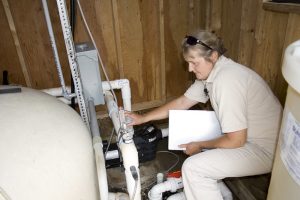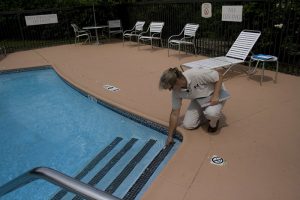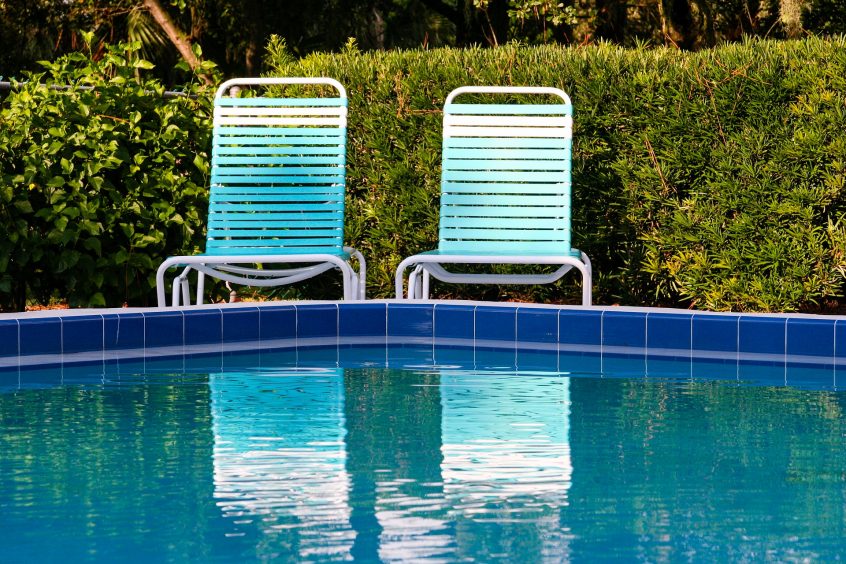Many pool professionals are challenged by the seasonality of the industry and look for new ideas that will keep sales flowing during the off-season. Performing energy audits for pool owners creates an innovative way to improve the bottom line and keeps professionals in front of their customers even during the winter months.
In today’s economic climate, homeowners are seeking ways to reduce costs as well as lessen their own impact on the environment, and pool owners are no different. They are interested in saving energy costs, reducing carbon emissions, lowering water consumption, and minimizing overall waste. Pool owners are changing their habits to embrace a greener environment. They are living a greener lifestyle by purchasing fuel-efficient automobiles, buying more organic foods, and using recycled products. This shift in attitude provides an opportunity for pool professionals to help pool owners meet their goals by offering energy-efficient technologies.
Energy audit programs
An energy audit program is one answer to help customers reduce expenses and embrace a greener future. Conducting an energy audit requires identifying opportunities for change as well as providing recommendations for energy and cost savings. Pool professionals can initiate an outreach program to existing pool owners and offer an assessment of their pool equipment and current energy usage.
The first step may be a letter, e-mail or perhaps a postcard mailer to their existing customer base, indicating a nominal fee to review the customer’s pool operation. Most pool auditors credit back the fee if the homeowner opts to purchase newer equipment or renovations.
The audit requires a visual inspection of the pool with a detailed review of what resources are being used, how much, and the state of the equipment. This will be the baseline to support future recommendations. The audit should assess all operational systems: pumps, filters, heaters, chemical treatment, lighting, and controls.
| WHAT TO INCLUDE IN AN ACTION REPORT |
|---|
| After the on-site inspection and all equipment parameters have been analyzed, including a thorough review of the usages and costs, a comprehensive action report can be achieved. The report should indicate which areas of the pool need to be modified or renovated to reduce energy consumption. Recommendations for installation of new equipment and pool owner return on investment (ROI) should be included. ROI is important because it measures the cost of investing in the changes against how long it will take to recoup their investment based on energy savings. The audit team should demonstrate how much the pool owner is currently spending and compare it to what they can potentially save by implementing any of the audit recommendations. This compelling data can be the deciding factor in a pool owner’s decision to upgrade their pool equipment. Finally, the audit team should research current energy rebate programs offered by various municipalities and present them to the pool owner in the action report. |
Phase 1: Assemble the audit team
The audit team’s job is to inspect the pool and document all the existing parameters that have an effect on energy consumption. Both field technicians and retail store staff should be involved, which helps them understand the value of offering energy audits and how they work.
Phase 2: The initial review

Create an audit checklist that includes the location, pool volume (litres/gallons), and manufacturer’s equipment information (e.g. pump performance curves and flow rates, filter size and media rate, and current heating appliance and efficiency ratings).
Create an audit checklist that includes the location, pool volume (litres/gallons), and manufacturer’s equipment information (e.g.pump performance curves and flow rates, filter size and media rate, and current heating appliance and efficiency ratings). It is also important to assess all of the old equipment as well as the amount of energy used to operate it. Ask the homeowner to provide at least six months of utility bill information (e.g. electrical and gas) as this data will assist in calculating the energy savings during the recommendation phase. An on-site visual inspection is also vital to the recommendation phase as it provides the audit team with the information necessary to make appropriate recommendations. The following are some key areas to watch for when performing an on-site visual inspection:

An on-site visual inspection is also vital to the recommendation phase as it provides the audit team with the information necessary to make appropriate recommendations.
Swimming pool structure
The swimming pool structure is sometimes overlooked as being a large contributor to added energy costs. Heating costs represent a large expense in swimming pool operation. If there is a leak in the concrete structure, plumbing, or through the vinyl liner, the homeowner is spending wasteful dollars to heat their pool due to the addition of replacement water, which is also an added expense.
With the cost of fossil fuel climbing in every region, it makes good sense to recommend pool owners spend the money necessary to correct these leaks. For example, if a pool is losing 25.4 mm (1 in.) of water per week, this amounts to 2,366 L (625 gal) in 93 m2 (1,000 sf) of surface area. Over the course of a year, even a small 4.8- x 9.7-m (16- x 32-ft) pool will waste 62,080 L (16,400 gal). This is not only an added expense when considering water consumption, but also loss of chemicals and heating. By showing these figures to the pool owner, it will be easier to impress upon them the value of fixing the leak.
Filtration
Sand filtration systems require water usage during the backwashing cycle. Part of the energy audit should be an inspection of the filters, including age of the system, sand replacement intervals, and the time required to clean (i.e.backwash) the system.
The litres/gallons backwashed to the waste system can be calculated based on flow rates. Backwashing filter dirt and debris (along with pool chemicals) into lakes and streams can impact the environment as well as create a hazard to aquatic ecosystems downstream.
In this case, the audit team may suggest the pool owner use a different filter media (e.g. zeolite, cartridge, etc.).
Lighting
The quantity and condition of pool and spa lights, wattages, amps and volts all influence energy draw. The energy auditor can have a discussion with the owner to help them understand the overall lighting cost, and when they would like the lights on. This can be calculated using Ohm’s Law: Amps x Volts = Watts and converting to kilowatt hour (kWh) usages, which is the same way electrical utilities calculate charges.
Inspecting all connections and conditions of the lighting is also important. The industry offers an array of energy-efficient, light-emitting diode (LED) lighting systems that can be retrofitted to traditional halogen fixtures.
| HOW TO BECOME A CERTIFIED AQUATIC ENERGY AUDITOR |
|---|
Conducting an audit is the first step to improving energy efficiency. The Online Certified Aquatic Energy Auditor (CAEA) course from the National Swimming Pool Foundation (NSPF) is designed for aquatic professionals to audit and recommend energy-efficient concepts and improvements. The course will include:
|
Pumps and motors
In some regions, utility suppliers report pool pumps/motors are typically one of the top three appliances responsible for energy consumption.
When inspecting the pump, the audit team should examine its performance against the original pump curve provided by the manufacturer. The use of a pressure gauge and vacuum gauge can provide the total dynamic head (TDH) necessary to read the pump curve. Install a vacuum gauge on the suction side of the pump (the drain plug under the hair and lint basket) and the pressure gauge on the pressure side of the pump (the drain plug under the impeller). Then, multiply the vacuum gauge reading by 1.13 and the pressure gauge reading by 2.31 and add these two calculations together to get the TDH.
Finally, compare the results to the pump curve to ascertain the pump is performing to the optimal litres/gallons per minute. Over time, impellers can become damaged, which strain the pump, lower flow rates, and increase electrical costs. The audit team should also check the current pump to determine whether cavitation is occurring.
Two-speed, variable- and multi-speed pumps and motors are available for residential pool retrofits, with some utilities offering rebates to homeowners. The audit team, however, should be cautious when calculating the correct energy savings as to avoid ‘greenwashing’ (i.e. promoting the perception that a product is environmentally friendly) or overstating energy savings.
Toxicity
Consumers interested in greening their environments are also concerned about how household chemicals may impact their health. This is an important discussion point for pool owners, too.
Many of the sanitizers typically used in pool chemical treatments are hazardous. Creating a sustainable pool environment requires elimination of toxic chemicals. The audit team should conduct a complete overview of chemical types and usages in an effort to switch the consumer to a more user-friendly chemical treatment. For example, the use of electrolytic chlorine generators (ECG) (i.e. saltwater chlorinators) is gaining popularity, partly because they are non-toxic and safe to handle.
Controllers
Not only do today’s homeowners have the convenience of turning household heating/cooling and lighting on and off with the use of an automation system and controller, they can also operate their swimming pool or hot tub in the same manner. When upgrading to a more energy efficient pool, the energy auditor should assess the need for a pool controller and help the customer determine the best automation system for their needs.
Phase three: Analyze results and develop recommendations
During this phase, the findings should be analyzed and used to compile a list of recommendations. Then, draft a proposal outlining where and how the homeowner can conserve energy, e.g. equipment upgrades. This may seem like an overwhelming task; yet, the winter season is the perfect time to take on these types of projects when other business is slow.
It is also an opportune time to get the customer’s attention by committing to helping them reduce their expenses. In doing so, pool professionals become a proactive participant, not just responding when equipment breaks down, creating a win-win for pool owners.
How can an energy audit team boost sales and profits?
What homeowner does not want to save money? A swimming pool energy audit is a great service for both existing and new customers as it enables them to lower their energy costs, water consumption, and toxicity.
An energy audit will not only help pool owners realize their commitment to a greener lifestyle, but also create a more positive pool ownership experience. Getting started will require some time in team training and education; however, in the long-term, educated professionals instill confidence in the customer, which will only ensure greater success for the business.
This article was written by Connie Sue Centrella and originally appeared on Pool & Spa Marketing [link].
